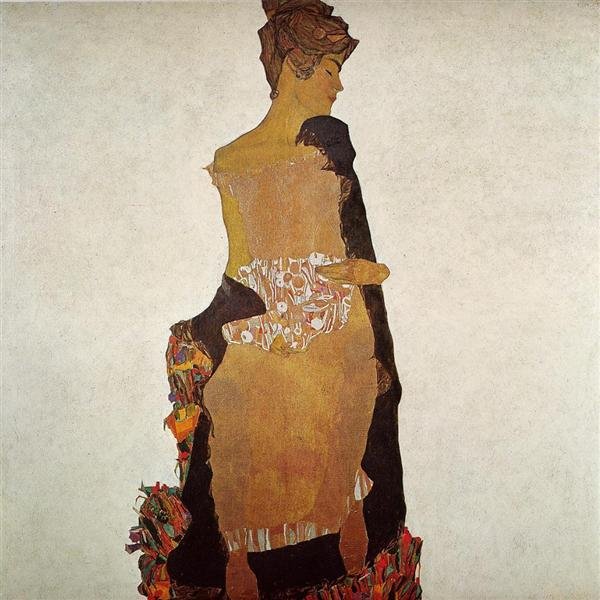

Egon Schiele story

In the flickering gaslight of early 20th-century Vienna, where the air was thick with the scent of revolution—artistic, political, and philosophical—one young artist burned brighter, and more intensely, than most. Egon Schiele was not merely a painter; he was a force of nature, a raw nerve exposed to the world. His work, both haunting and magnetic, demanded that viewers confront the unsettling beauty of the human condition.
Born in 1890 in Tulln, Austria, Schiele’s talent emerged early, a beacon too bright for the small town that could barely contain his restless spirit. He enrolled in Vienna’s Academy of Fine Arts at just sixteen, but the rigid, traditional instruction left him stifled. Then came Gustav Klimt—the master of sensual elegance—who saw in Schiele something even he did not fully understand. Klimt became his mentor, pushing him beyond the academy’s conventions and into the avant-garde world of eroticism and emotional rawness.
Schiele’s work was electrifying, but it was not safe. His figures—gaunt, distorted, writhing in silent agony or unabashed sensuality—were too much for polite society. He painted self-portraits that bared his soul as much as his flesh, bodies that told stories of desire, loneliness, and mortality. His lines, sharp as a scalpel, cut through pretension, leaving only raw emotion on the canvas. Some called him a visionary. Others called him obscene.
The latter would soon cost him. In 1912, authorities arrested Schiele, accusing him of corrupting the youth with his explicit artwork. Police raided his studio, confiscating over a hundred drawings. Though the most serious charges were dropped, he was found guilty of displaying inappropriate material to minors. He spent 24 days in a small, damp cell—an experience that left an indelible scar on his psyche. His jail time marked a turning point, tempering his art with a deeper sorrow, a sense of impending doom that would become eerily prophetic.


Then came war. In 1914, as the world descended into chaos, Schiele was conscripted into the Austrian army. Unlike so many artists of his time, he survived, returning to a Vienna where his star was finally rising. By 1918, he was at the peak of his career, preparing for a grand exhibition that promised to cement his place in history. But fate had other plans.
That autumn, the Spanish flu swept through Europe, a silent killer more ruthless than the war itself. Schiele’s pregnant wife, Edith, was the first to fall. He sketched her in her final hours, the lines trembling with grief. Three days later, on October 31st, Egon Schiele was dead. He was only 28.
And yet, he was immortal.
Schiele left behind a legacy that continues to shock, inspire, and mesmerize. His influence pulses through the veins of contemporary art, his spirit lingering in every raw, unfiltered exploration of the human form. He lived fast, painted fiercely, and died young, but his work refuses to be buried. Egon Schiele’s tormented brilliance endures—a testament to art’s power to disturb, provoke, and, ultimately, transcend time.
3. Late Period: “Town among Greenery (The Old City III)” (1917)
1. Early Period: “Portrait of Gerti Schiele” (1909)
This portrait depicts Schiele’s younger sister, Gerti, who was a frequent model during his formative years. Painted when Schiele was just 19, it showcases the influence of his mentor, Gustav Klimt, evident in the decorative elements and use of gold and silver accents. However, Schiele’s emerging style is apparent in the muted color palette and the sculptural quality of Gerti’s depiction, suggesting a departure from Klimt’s more ornamental approach.
2. Mid-Career: “Death and the Maiden” (1914-1915)
Created during a tumultuous period in Schiele’s life, this painting reflects themes of love, loss, and mortality. It portrays a gaunt female figure clinging to a male figure, often interpreted as a personification of death. Art historians believe this work symbolizes Schiele’s separation from his longtime lover, Wally Neuzil, and his impending marriage to Edith Harms. The haunting imagery and emotional depth mark a maturation in Schiele’s artistic expression.
3. Late Period: “Town among Greenery (The Old City III)” (1917)
In the final years of his life, Schiele expanded his focus to include landscapes and cityscapes. This painting offers a bird’s-eye view of Krumau, his mother’s hometown, characterized by bold outlines and sharp contours. The vibrant colors and intricate detailing demonstrate Schiele’s versatility and his ability to infuse inanimate subjects with emotional resonance.
These works encapsulate the progression of Schiele’s artistry, from early explorations influenced by his mentors to the development of a distinctive, emotionally charged style that continues to captivate audiences today.
